While Shopify leads the ecommerce platform market, many businesses try to find better alternatives for their specific needs. Different platforms offer lower costs, more built-in features, or greater control over your online store.
Key Takeaways:
- Some alternatives like BigCommerce and Adobe Commerce offer stronger B2B features than Shopify
- Free options exist for different business sizes - from WooCommerce for any scale to Big Cartel for small catalogs
- Platforms like Wix and Squarespace excel at combining content with commerce, unlike Shopify’s commerce-first approach
- US merchants can get enterprise-level features for free with Shift4Shop, compared to Shopify’s paid-only model
- Open-source alternatives give you complete control over your store’s code and costs, while Shopify limits customization
Comparison of Best Shopify Alternatives 2025
Below is a comprehensive comparison of the top e-commerce platforms that serve as alternatives to Shopify. Each platform is evaluated based on its pricing structure, key differentiating features, target audience, and potential limitations.
| Platform | Starting Price | Key Difference from Shopify | Main Drawback |
| BigCommerce | From $29/month | More built-in features with no transaction fees; stronger B2B capabilities. | More complex interface than Shopify |
| WooCommerce | Free + hosting costs | Free, open-source platform with complete code control and WordPress integration. | Requires technical management |
| Wix | From $29/month | Better design flexibility and built-in marketing tools. | Limited e-commerce features |
| Squarespace | From $27/month | Superior design templates and content creation tools. | Fewer integrations |
| Adobe Commerce | From $2,800/month | Enterprise-grade customization with complete code control. | High cost and complexity |
| PrestaShop | Free + hosting costs | Open-source with strong European market presence. | Requires development expertise |
| PinnacleCart | From $79.95/month | Built-in marketing tools and SEO features without need for apps. | Higher monthly costs and limited support hours |
| Shift4Shop | Free (US merchants) | Free for US merchants using Shift4 Payments. | Less intuitive interface |
| Big Cartel | Free for 5 products | Simple, artist-focused platform with free plan for up to 5 products. | Very limited features |
| Ecwid | From $25/month | Easily adds e-commerce to existing websites. | Limited standalone features |
Detailed Analysis of Top Shopify Alternatives for 2025
Each e-commerce platform offers unique advantages and specialized features that might make it a better fit for certain businesses than Shopify.
Let’s explore each alternative in detail to understand their strengths, limitations, and ideal use cases.
BigCommerce as a Shopify Alternative
BigCommerce takes a different approach to e-commerce than Shopify, focusing on built-in tools rather than relying on apps. This key difference shapes how each platform serves its users.
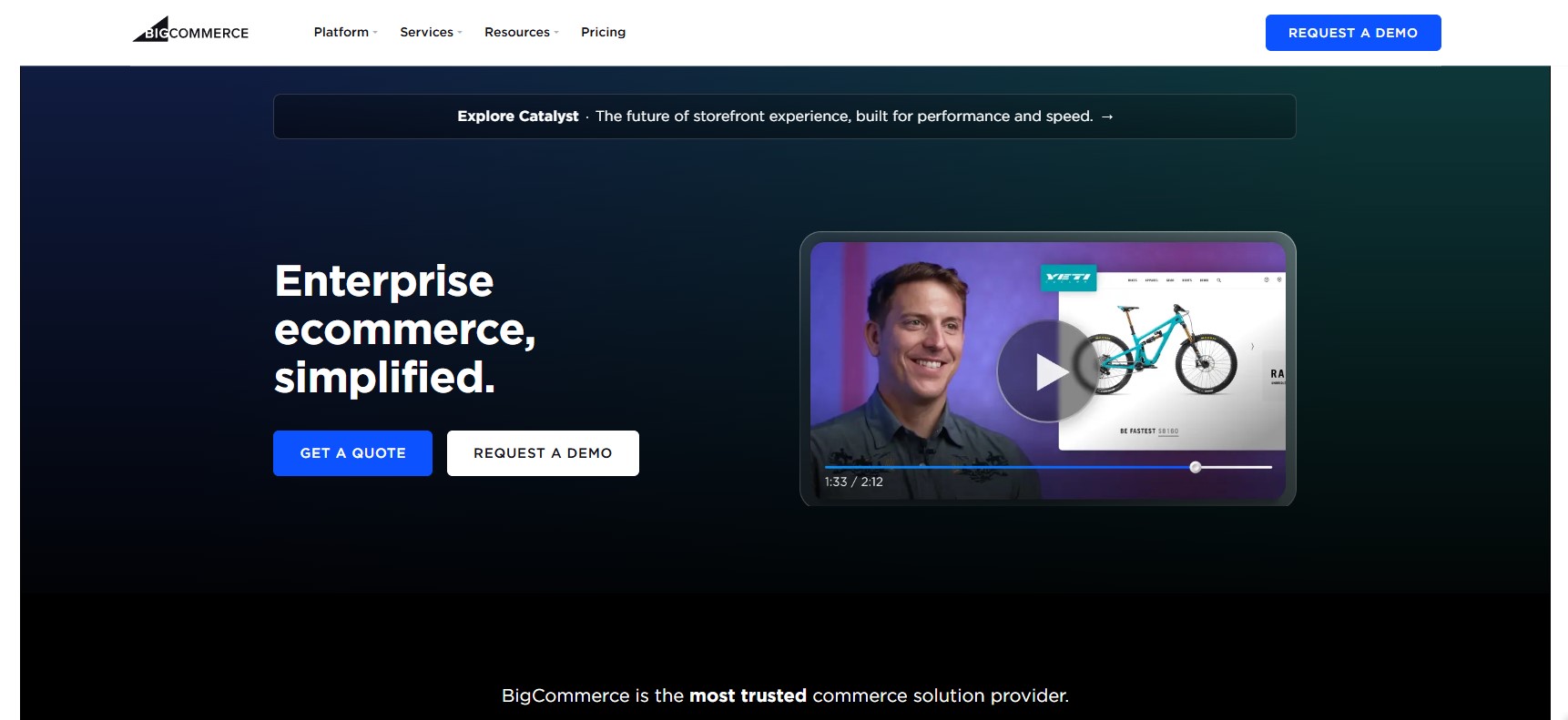
Cost Structure
The pricing model sets BigCommerce apart from Shopify in two important ways:
- No transaction fees with any payment gateway
- Clear sales volume limits for each plan tier
The Standard plan starts at $29 monthly and works well until you hit $50,000 in yearly sales. The Plus plan at $79 monthly takes you up to $180,000 in sales, while the Pro plan at $299 supports up to $400,000.
This structure helps businesses plan their costs without worrying about surprise fees.
Built-in Features
BigCommerce includes several tools in its base price that would cost extra with Shopify:
- Multi-currency selling
- Real-time shipping calculations
- Advanced product options
- Customer group management
- Basic B2B tools
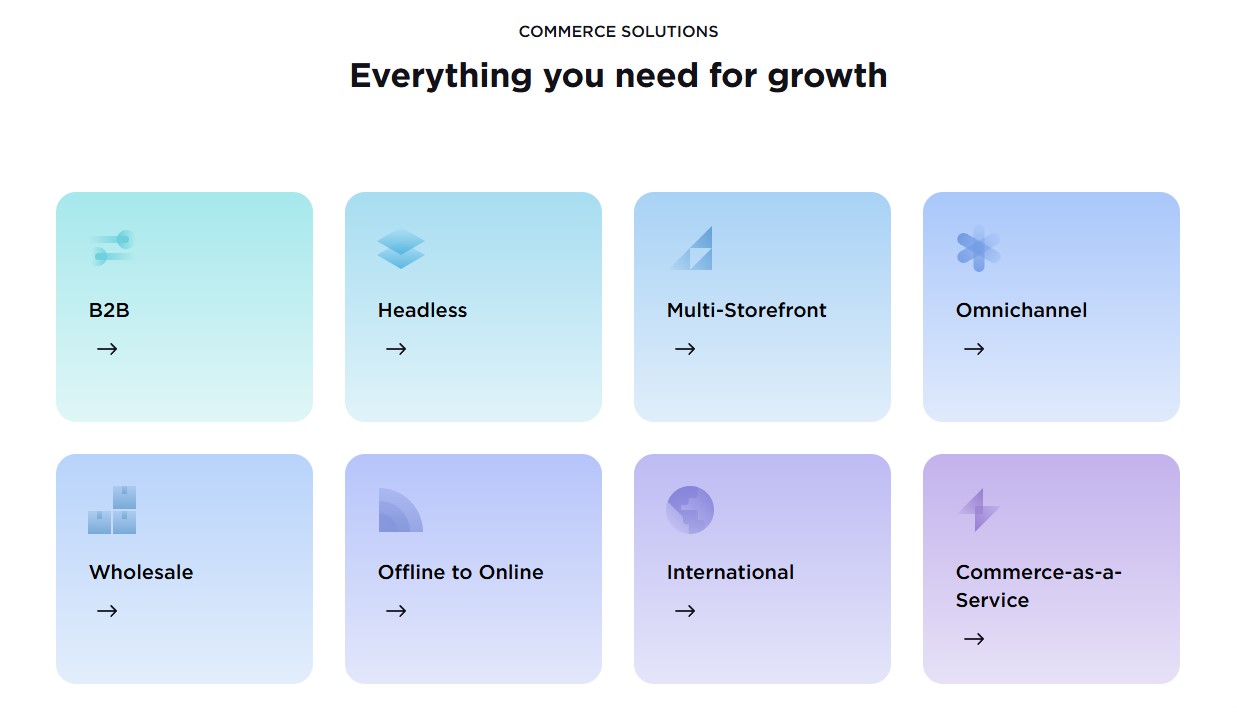
The platform handles complex product catalogs better than Shopify, supporting up to 600 variants per product compared to Shopify’s 100. This makes a real difference for stores selling items with many size, color, or style combinations.
B2B Capabilities
For businesses selling to other businesses, BigCommerce offers specialized features:
- Custom price lists for different customer groups
- Quote management system
- Bulk pricing options
- Company account management
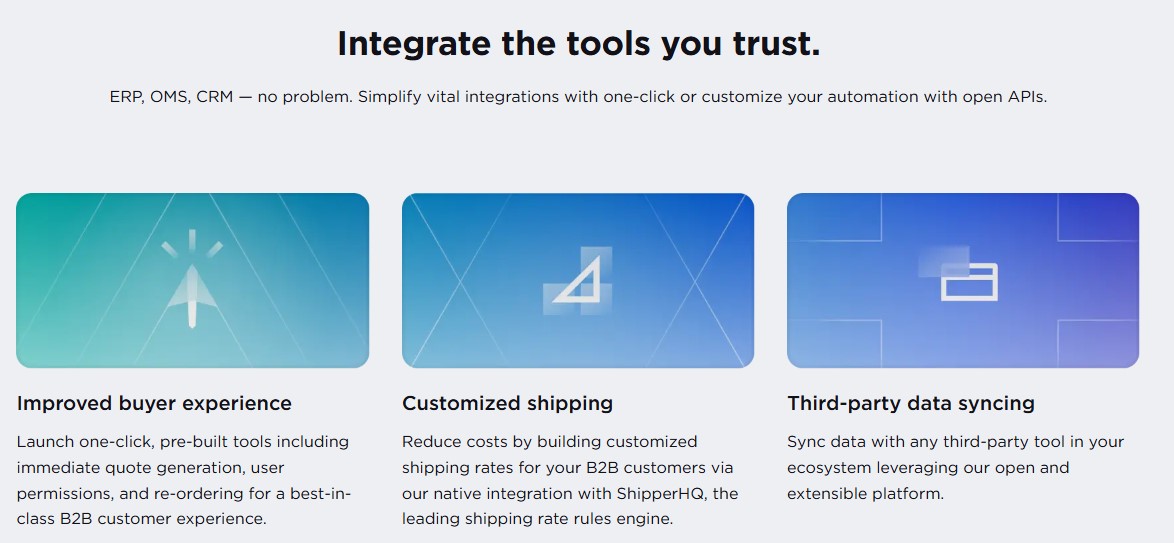
Where BigCommerce Falls Short
The trade-off for all these built-in features is a more complex system to learn. New users often need more time to get comfortable with BigCommerce than they do with Shopify.
The platform also offers fewer themes than Shopify, and its app store has about 1,500 integrations - notably less than Shopify’s 8,000.
Bottom Line
Choose BigCommerce if you want to avoid extra app costs and need strong product management tools. It works especially well for businesses that mix B2B and B2C sales.
However, if you prefer a simpler starting point and don’t mind paying for additional apps as you grow, Shopify might be a better fit.
WooCommerce as a Shopify Alternative
WooCommerce, launched in 2011 by developers Mike Jolley and James Koster, is an open-source e-commerce plugin for WordPress. It enables businesses to transform their WordPress websites into fully functional online stores.
As a widely used e-commerce solution, WooCommerce is known for its flexibility and extensive customization options.
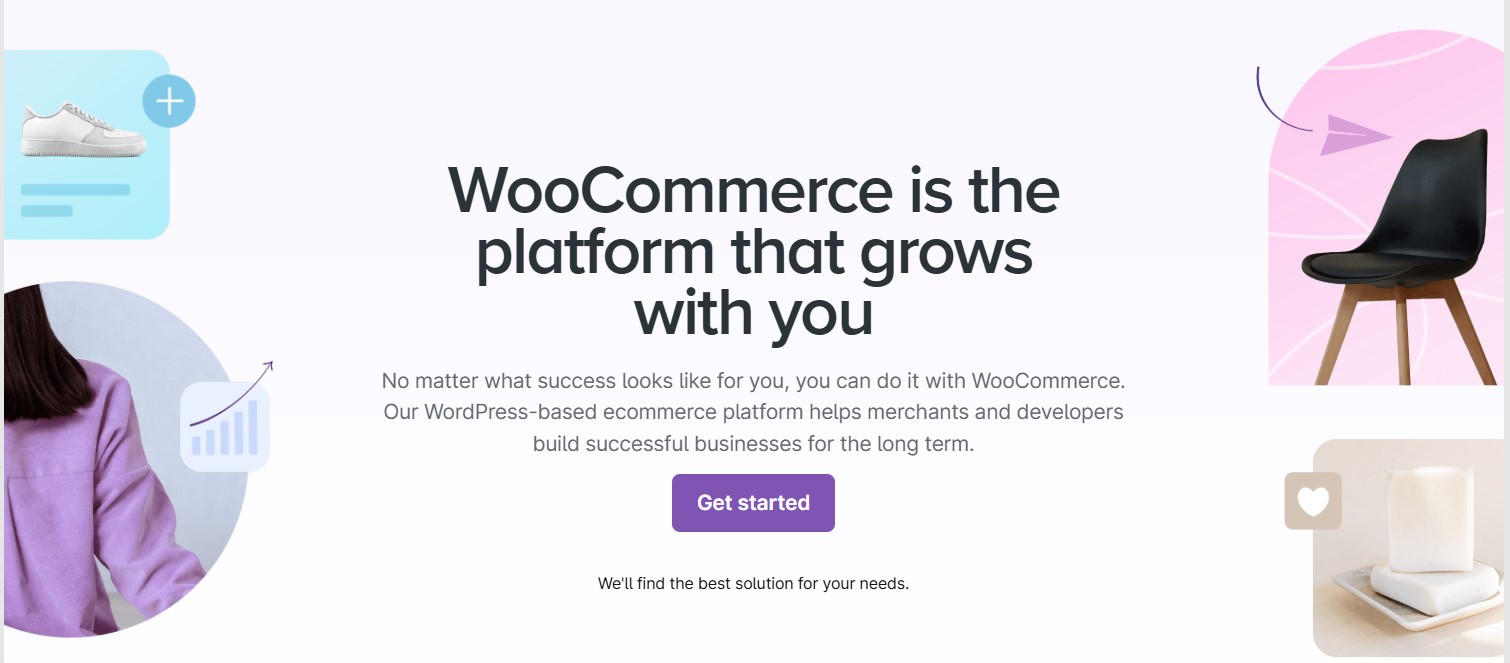
Cost Structure
The pricing model sets WooCommerce apart from Shopify in two important ways:
- No monthly platform fees
- Zero transaction fees on any payment gateway
The core WooCommerce plugin is free, but you’ll need to budget for hosting and a domain name. Basic hosting typically costs $3-5 monthly, with a domain name priced around $15 per year.
This cost structure offers greater flexibility, allowing you to scale expenses based on your needs instead of adhering to fixed plan tiers.
Built-in Features
WooCommerce combines WordPress’s powerful content management with strong e-commerce capabilities. The platform includes several essential tools in its free core:
- Complete website building capabilities
- Blogging and content marketing tools
- Unlimited products and variations
- Multi-currency support
- Basic inventory management
The integration with WordPress makes WooCommerce particularly strong for content-driven commerce, allowing you to build a full-featured website alongside your store without additional costs.
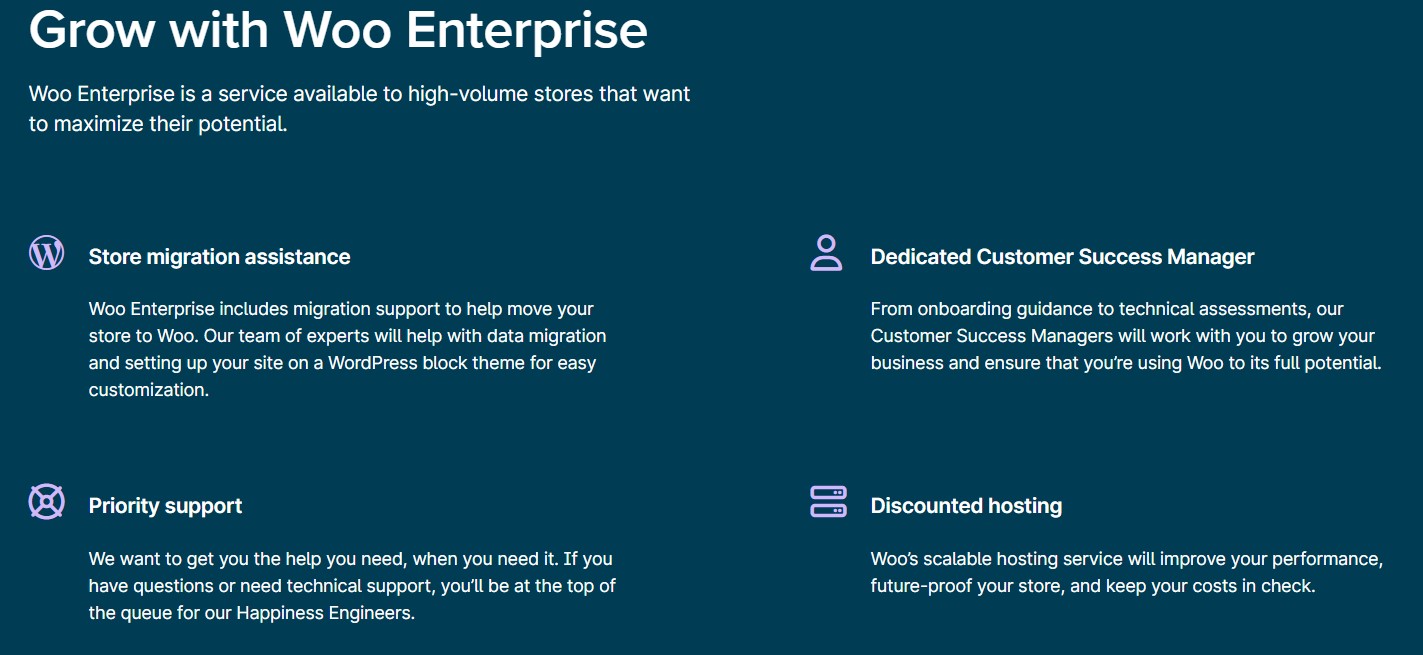
Technical Control
WooCommerce’s biggest advantage is the level of control it provides. You can:
- Modify any aspect of your store’s code
- Choose your preferred hosting provider
- Scale resources according to your needs
- Access your data directly
- Create custom functionality
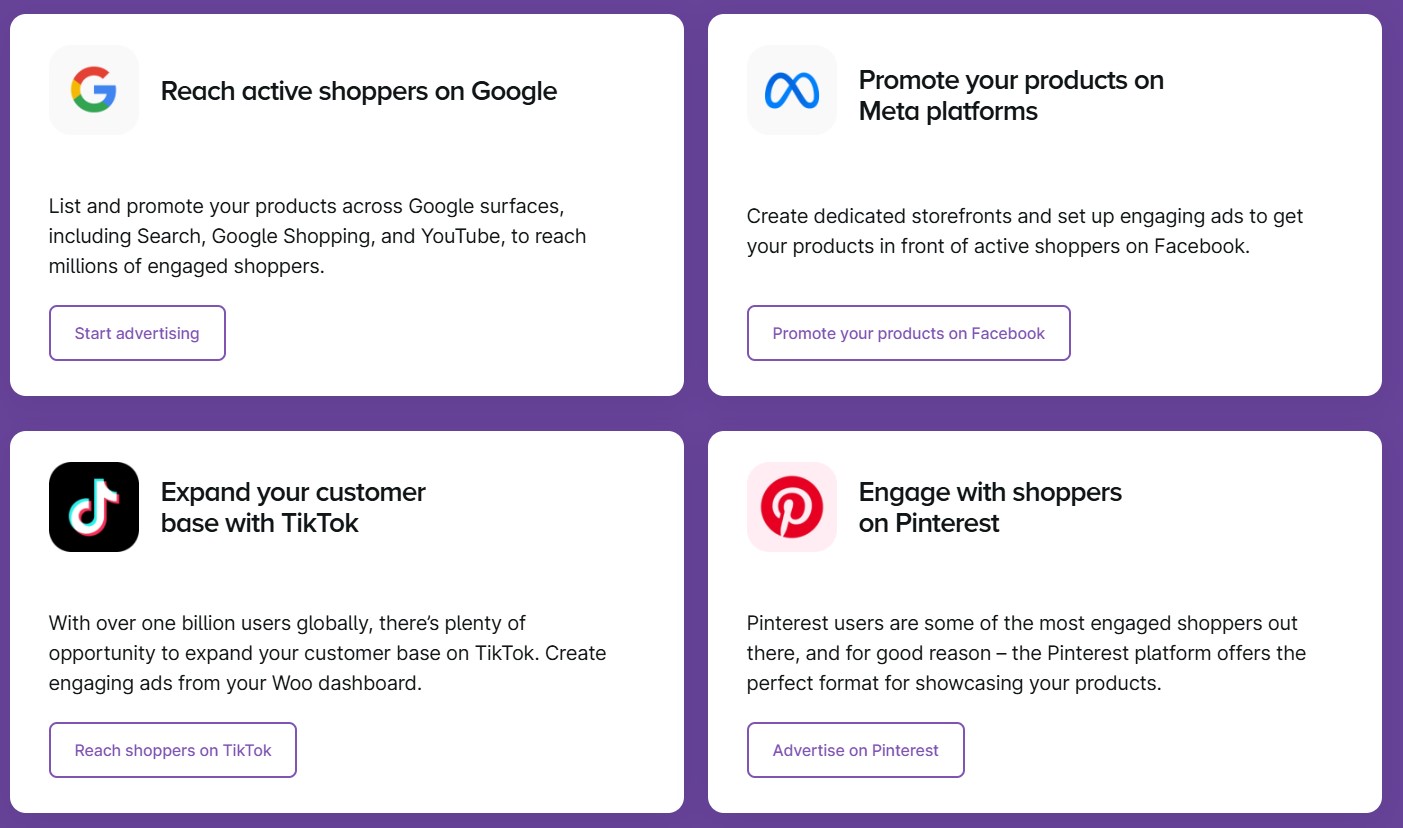
Where WooCommerce Falls Short
The trade-off for this flexibility is increased responsibility. You’ll need to manage your own hosting, security, and maintenance, which requires more technical knowledge than Shopify’s managed platform.
The initial setup can be more complex, and you’ll need to stay on top of updates and optimization.
While there’s extensive community support, you won’t have the centralized customer service that comes with hosted platforms.
Bottom Line
Choose WooCommerce if you want complete control over your store and don’t mind handling technical aspects. It works especially well for businesses that need strong content marketing capabilities or want to avoid platform fees.
However, if you prefer a hands-off solution that manages technical details for you, Shopify might be a better fit.
Wix as a Shopify Alternative
Founded in 2006 by Avishai Abrahami, Nadav Abrahami, and Giora Kaplan, Wix is a cloud-based platform that specializes in website creation and e-commerce.
It offers an intuitive interface and extensive design options, making it a popular choice for small businesses and individuals.

Cost Structure
The pricing model sets Wix apart from Shopify in two important ways:
- No transaction fees beyond payment processor costs
- Lower-cost entry plans with more included features
The Core plan starts at $29 monthly with all essential e-commerce features included, while the Business plan at $36 monthly adds advanced capabilities. This transparent structure lets businesses avoid the extra fees and app costs often associated with Shopify.
Built-in Features
Wix combines website building and ecommerce capabilities in one platform. The base platform includes several tools that would require extra apps in Shopify:
- Advanced content editor with blogging
- Marketing automation tools
- Email marketing campaigns
- Social media integration
- Appointment booking system
The platform truly shines for businesses that need strong content capabilities alongside their store, offering a more comprehensive solution than Shopify’s commerce-focused approach.

Design Control
Wix provides design flexibility with its intuitive drag-and-drop editor. You can customize every aspect of your store’s appearance without coding knowledge, supported by:
- Over 900 customizable templates
- Freedom to place elements anywhere on the page
- Built-in image editing tools
- Custom animations and effects
- Mobile editor for device-specific layouts
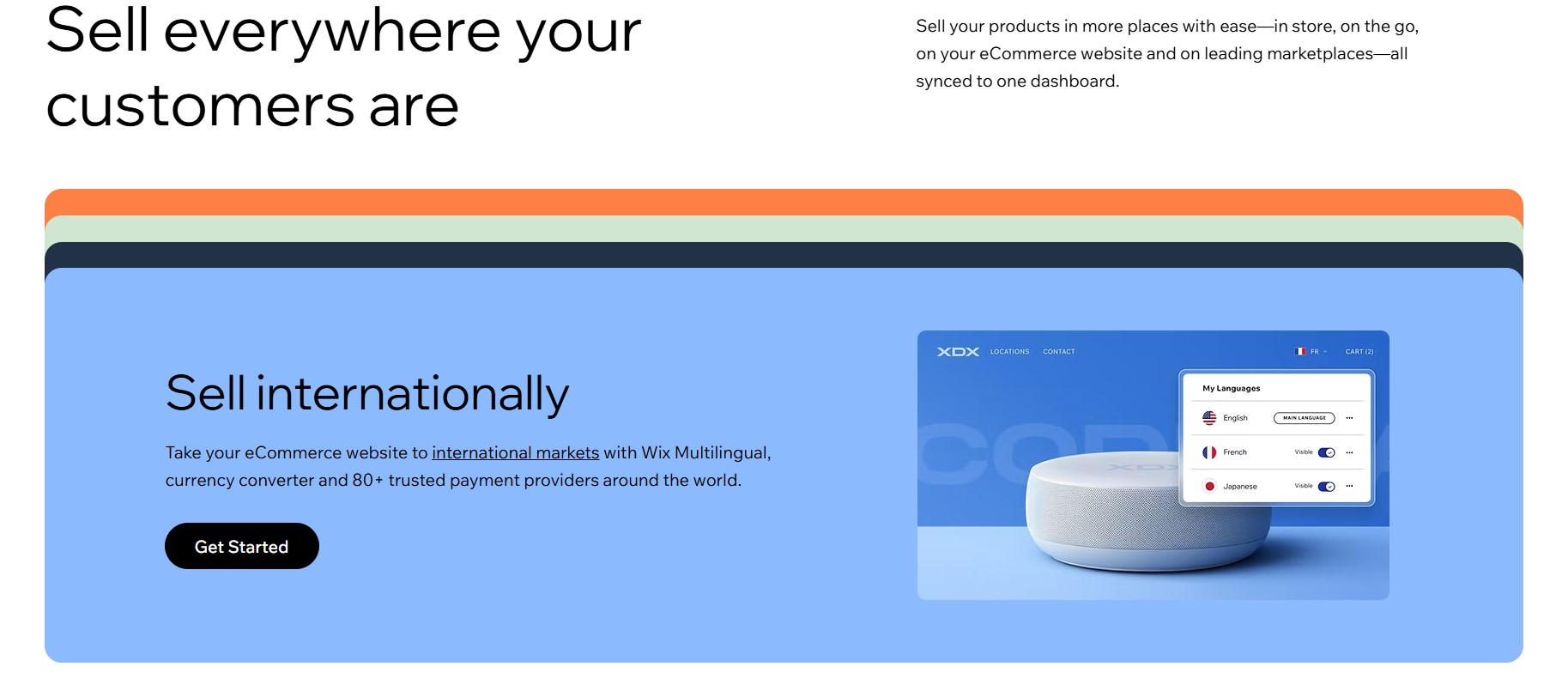
Where Wix Falls Short
The trade-off for this flexibility comes in e-commerce limitations. Wix’s inventory management isn’t as robust as Shopify’s, and the platform struggles with larger catalogs. Mobile optimization requires manual adjustments, unlike Shopify’s automatic responsive design.
International selling capabilities are also more limited, with fewer options for multiple currencies and cross-border commerce.
Bottom Line
Choose Wix if you need a strong content platform alongside your store and value design flexibility over advanced e-commerce features. It works especially well for small to medium-sized businesses that combine content marketing with selling.
However, if you’re planning to scale to a large product catalog or need strong international selling capabilities, Shopify might be a better fit.
Squarespace as a Shopify Alternative
Founded in 2003 by Anthony Casalena, Squarespace started as a platform for creating visually appealing websites and now includes e-commerce capabilities.
Squarespace is a good option if you prioritize design and content creation alongside selling.
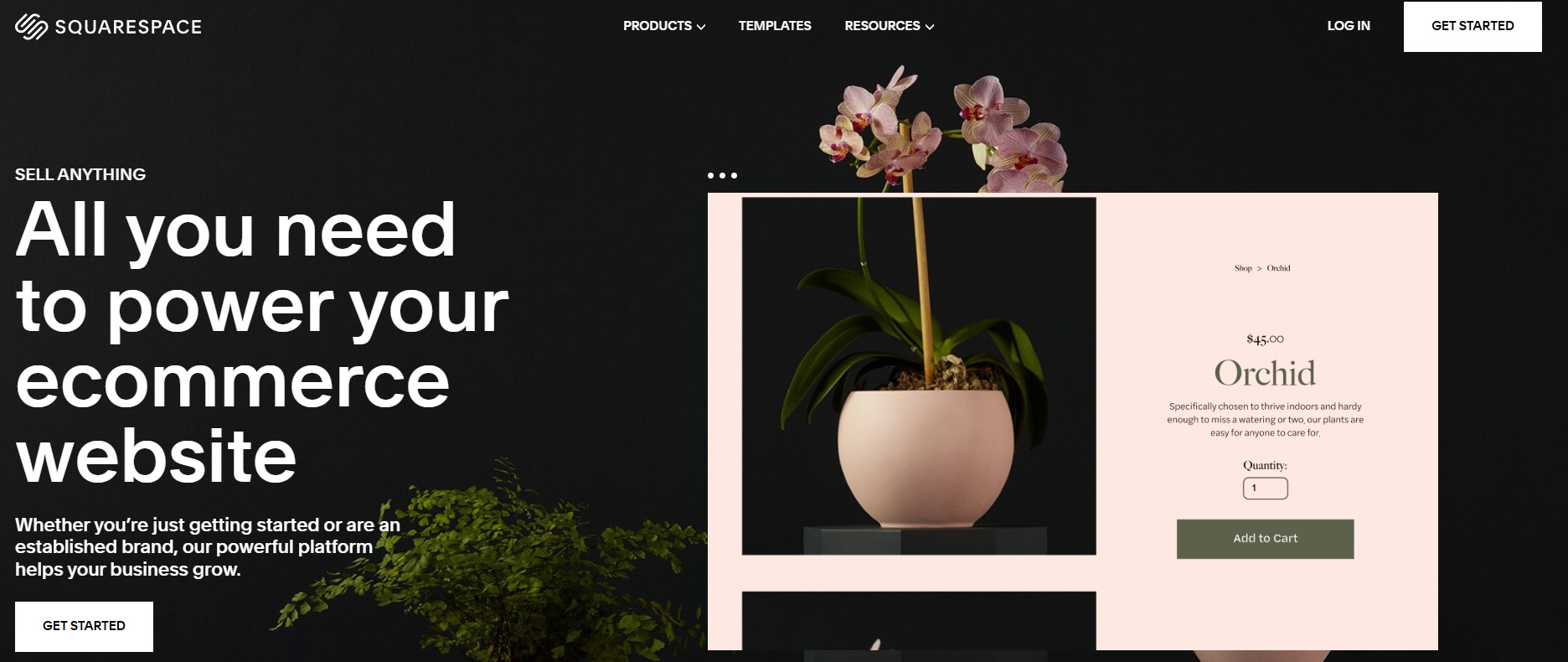
Cost Structure
The pricing model sets Squarespace apart from Shopify in several important ways:
- Plans range from $23-$52 monthly when billed annually
- No transaction fees on Commerce plans, only 3% on Business plan
- More inclusive features in base plans without extra app costs
- Predictable pricing with no steep jumps between tiers
The Commerce Basic plan starts at $28 monthly and includes professional email, complete customization tools, and basic commerce metrics.
The Advanced Commerce plan at $52 adds features like abandoned cart recovery and advanced shipping options.
Design Capabilities
Squarespace differentiates itself from Shopify through its extensive design tools and options:
- Over 200 free professional templates compared to Shopify’s 12
- Intuitive drag-and-drop editor for code-free customization
- Advanced product displays with 360-degree views
- Built-in professional blogging platform
The platform handles content creation better than Shopify, offering better layout options and integration between commerce and content pages.

Content Management
Squarespace supports content creation alongside e-commerce with features like:
- Multi-author blogging with scheduling capabilities
- Integrated email marketing tools
- Portfolio pages with gallery options
- Built-in SEO tools with keyword research

Where Squarespace Falls Short
The trade-off for the superior design tools is more limited ecommerce functionality.
The platform offers only three payment gateways (Stripe, PayPal, and Square), and its inventory management system struggles with large catalogs.
Third-party integrations are limited compared to Shopify’s extensive app marketplace, and the platform lacks native multi-channel selling capabilities.
Bottom Line
Choose Squarespace if you need a visually impressive site with solid ecommerce capabilities and don’t want to pay for additional apps.
It works particularly well for creative businesses, service providers, and smaller stores.
However, if you need advanced ecommerce features or plan to scale significantly, Shopify’s more robust commerce tools might be necessary.
Adobe Commerce (Magento) as a Shopify Alternative
Adobe Commerce, originally launched as Magento in 2008 and acquired by Adobe in 2018, is an open-source platform designed for businesses that require complete customization and enterprise-level e-commerce capabilities.
It is a powerful solution for those seeking full control over their online store.

Cost Structure
Adobe Commerce’s pricing differs significantly from Shopify’s fixed plans:
- Open Source version is free but requires hosting and maintenance costs
- Commerce edition starts at $22,000 annually
- Enterprise solutions begin at $2,800 monthly
- Additional costs include hosting, security, development, and maintenance
The platform’s flexible pricing structure means costs vary based on specific business needs and implementation choices.
While the initial investment is higher, it can be more cost-effective for large enterprises needing extensive customization.
Technical Capabilities
Adobe Commerce provides development flexibility that sets it apart from Shopify:
- Complete access to source code for custom development
- Support for unlimited product variants
- Advanced database management capabilities
- Custom API development options
- Sophisticated caching mechanisms for performance
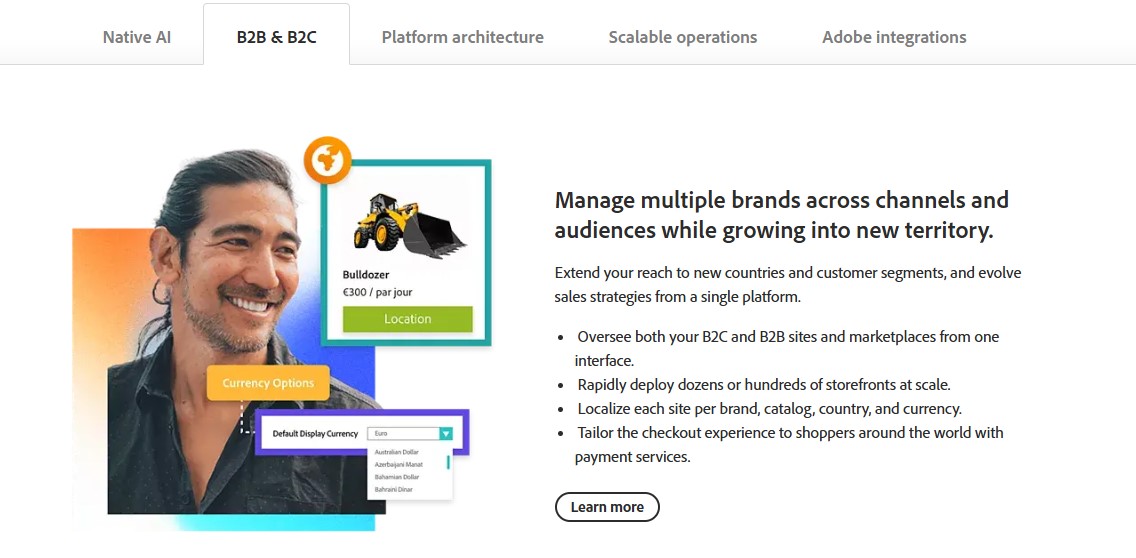
Built-in Features
The platform includes enterprise-grade tools as standard:
- Advanced inventory management system
- Complex product configuration options
- Multi-store management from one backend
- Built-in staging and preview capabilities
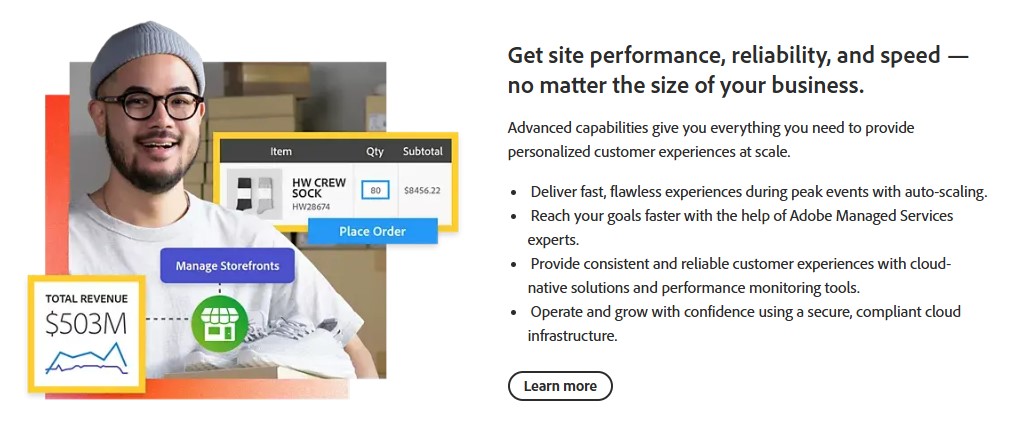
Where Adobe Commerce Falls Short
Adobe Commerce’s powerful capabilities come with notable limitations. Setting up and maintaining the platform demands significant technical expertise and a dedicated development team.
The initial investment is substantial, covering licensing, hosting, and development costs.
Launching a store takes longer than with Shopify, while system updates and security management require complex processes.
Staff members also face a steeper learning curve when using the platform’s advanced features.
Bottom Line
Choose Adobe Commerce if you need complete control over your ecommerce environment and have the technical resources to support it. It works particularly well for large enterprises with complex requirements and custom development needs.
However, if you want a simpler, more manageable solution with predictable costs, Shopify’s approach might be more suitable.
PrestaShop as a Shopify Alternative
PrestaShop, launched in 2007, is an open-source e-commerce platform that allows you to build and manage your online store with complete control over its setup and operation.
The platform is especially appealing if you want flexibility and customization options for your business.
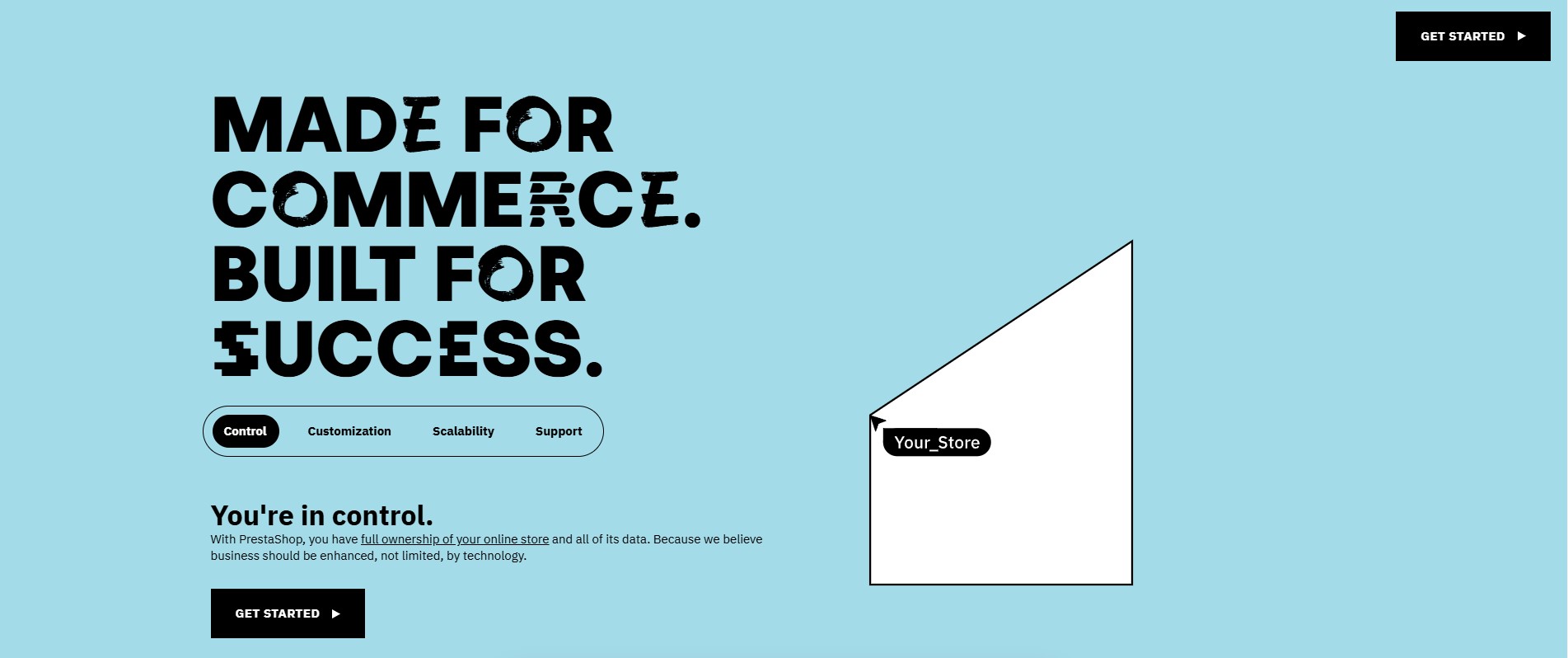
Cost Structure
PrestaShop has a unique pricing model that differs from Shopify’s fixed plans:
- Software is free to download and install
- Hosting costs range from $3-$7 monthly
- One-time theme costs between $91-$303
- Modules and add-ons cost between $35-$6000 depending on needs
- Transaction fees vary by payment gateway choice
While the initial software is free, store owners need to factor in these additional costs to run their store effectively.
Technical Setup
Using PrestaShop requires a higher level of technical involvement compared to Shopify.
You need to select and set up hosting, install and configure the software, and manage security for your store.
Regular maintenance, updates, and database management are also necessary tasks.
- Hosting selection and setup
- Installation and configuration of the software
- Security management and updates
- Database setup and ongoing maintenance
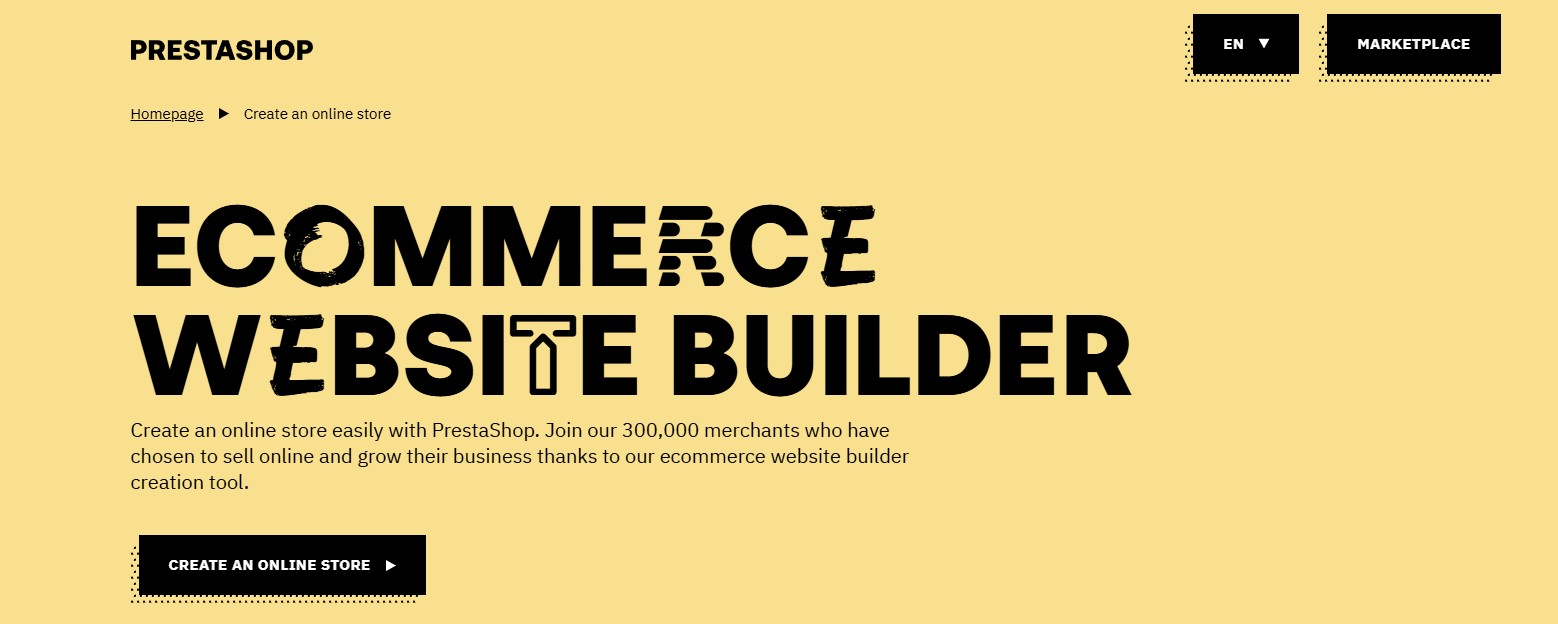
Built-in Features
PrestaShop offers a range of useful tools for managing an online store. It supports multiple languages and currencies, making it suitable for international markets. The platform includes:
- Product catalog management
- Customer group segmentation
- A basic CMS for creating and managing content pages
- Built-in SEO tools to enhance visibility
- Analytics for monitoring store performance
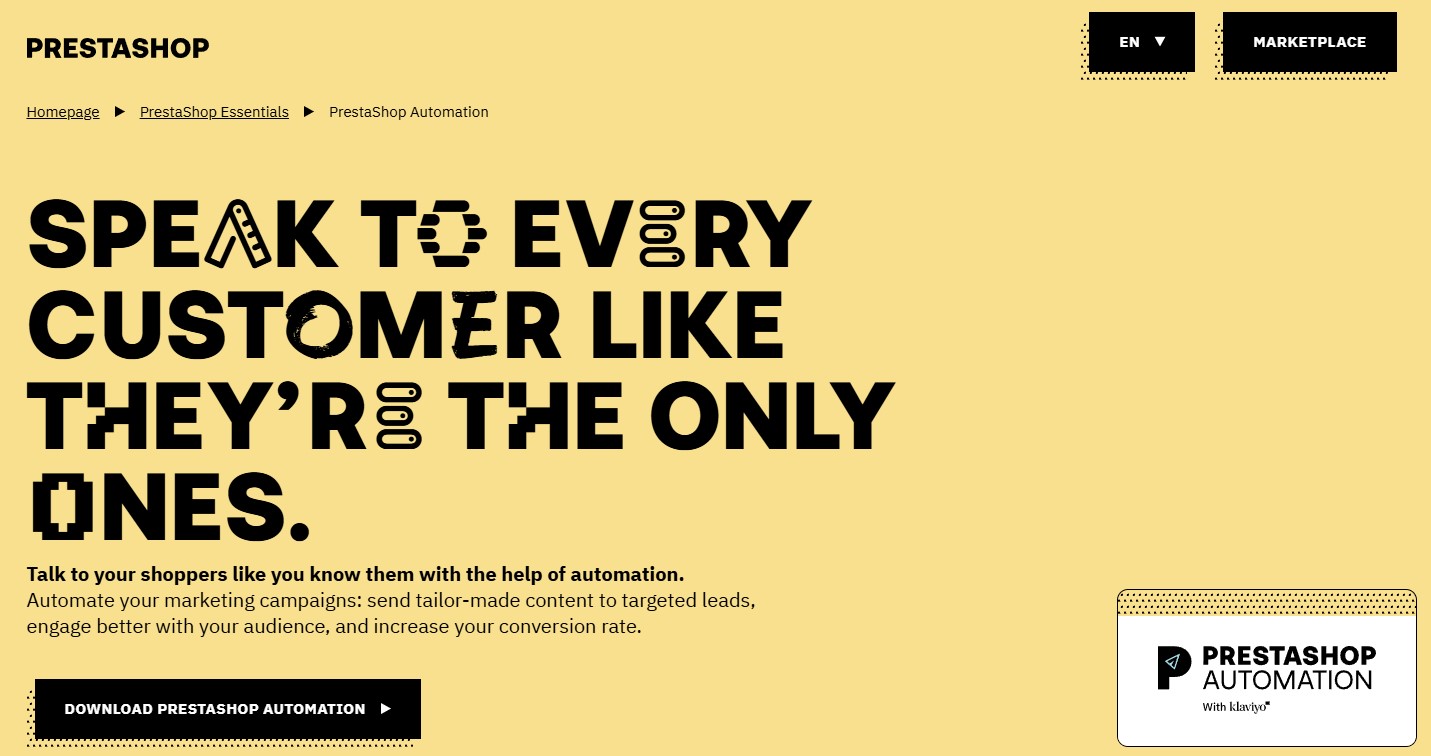
Where PrestaShop Falls Short
PrestaShop’s limitations become clear in its daily operations. The platform requires basic coding skills just to set up a store, while basic tasks take longer to complete than on Shopify.
Store owners must set aside time each month to handle updates and maintenance tasks themselves.
When problems arise, getting help costs extra money since PrestaShop charges for support services.
New users also need more time to learn the platform’s features compared to more straightforward alternatives.
Bottom Line
Choose PrestaShop if you want complete control over your store and don’t mind handling technical tasks. It works well for businesses with technical knowledge or those willing to hire developers.
However, if you prefer a simpler solution where technical details are handled for you, Shopify might be a better choice.
Shift4Shop as a Shopify Alternative
Shift4Shop (formerly 3DCart) takes a different approach from Shopify by offering a free plan for US merchants while providing enterprise-level features.
This creates a distinct option for businesses looking to minimize upfront costs.

Cost Structure
Shift4Shop’s pricing model differs markedly from Shopify’s approach:
- Free End-to-End plan for US merchants processing over $500 monthly
- Paid plans start at $29 monthly if not using Shift4 Payments
- Credit card fees of 2.9% + $0.30 per transaction
- No additional transaction fees with Shift4 Payments
Built-in Features
Shift4Shop includes several tools designed to meet essential e-commerce needs. For example, it offers single-page checkout and advanced SEO tools to enhance the shopping experience.
Additionally, features like pre-order capabilities and loyalty rewards help keep customers engaged.
Key tools include:
- Single-page checkout for streamlined transactions
- Product reviews and comparisons to aid purchasing decisions
- Unlimited product variants to support diverse catalogs
- Gift certificates and built-in loyalty programs

Inventory Management
The platform provides comprehensive inventory tools to handle complex product catalogs. Features such as digital downloads support and bulk product updates simplify managing large inventories.
Additionally, saved cart functionality and detailed reporting make it easier to track and optimize stock levels.
Highlights include:
- Support for digital products and downloads
- Multiple inventory tracking methods
- Detailed inventory reporting for actionable insights
- Bulk product updates for efficient catalog management
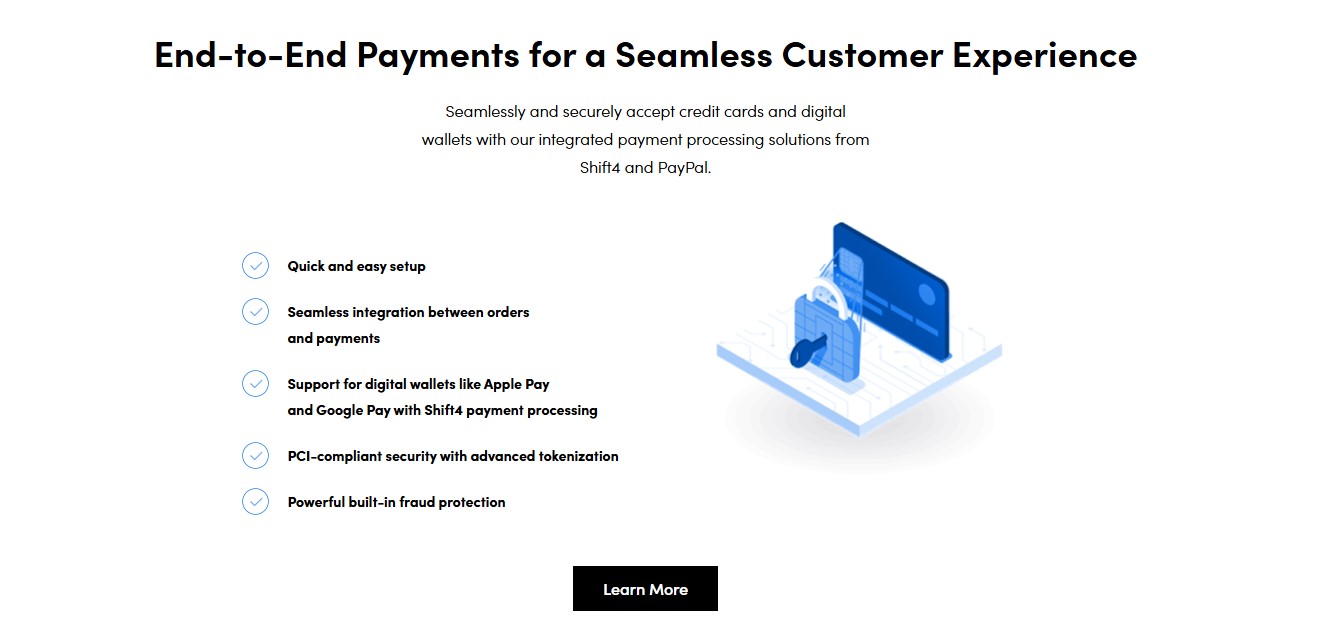
Where Shift4Shop Falls Short
The platform shows clear limitations in daily use. Setting up a store takes more time than with Shopify, and the interface feels dated and less intuitive.
The theme customization process is split across multiple editors, making design changes unnecessarily complex.
While the platform offers many features, finding and using them can be frustrating due to the scattered layout of tools across the dashboard.
Bottom Line
Choose Shift4Shop if you’re a US merchant wanting a free solution with built-in features and don’t mind working with a less polished interface.
It works particularly well for businesses needing complex product management without extra costs.
However, if you want a more streamlined experience and don’t mind paying monthly fees, Shopify might be a better choice.
PinnacleCart as a Shopify Alternative
PinnacleCart is designed to cater to medium-sized businesses, offering built-in marketing tools and SEO features that reduce the need for additional apps.
It aims to provide all essential ecommerce capabilities in a single platform.
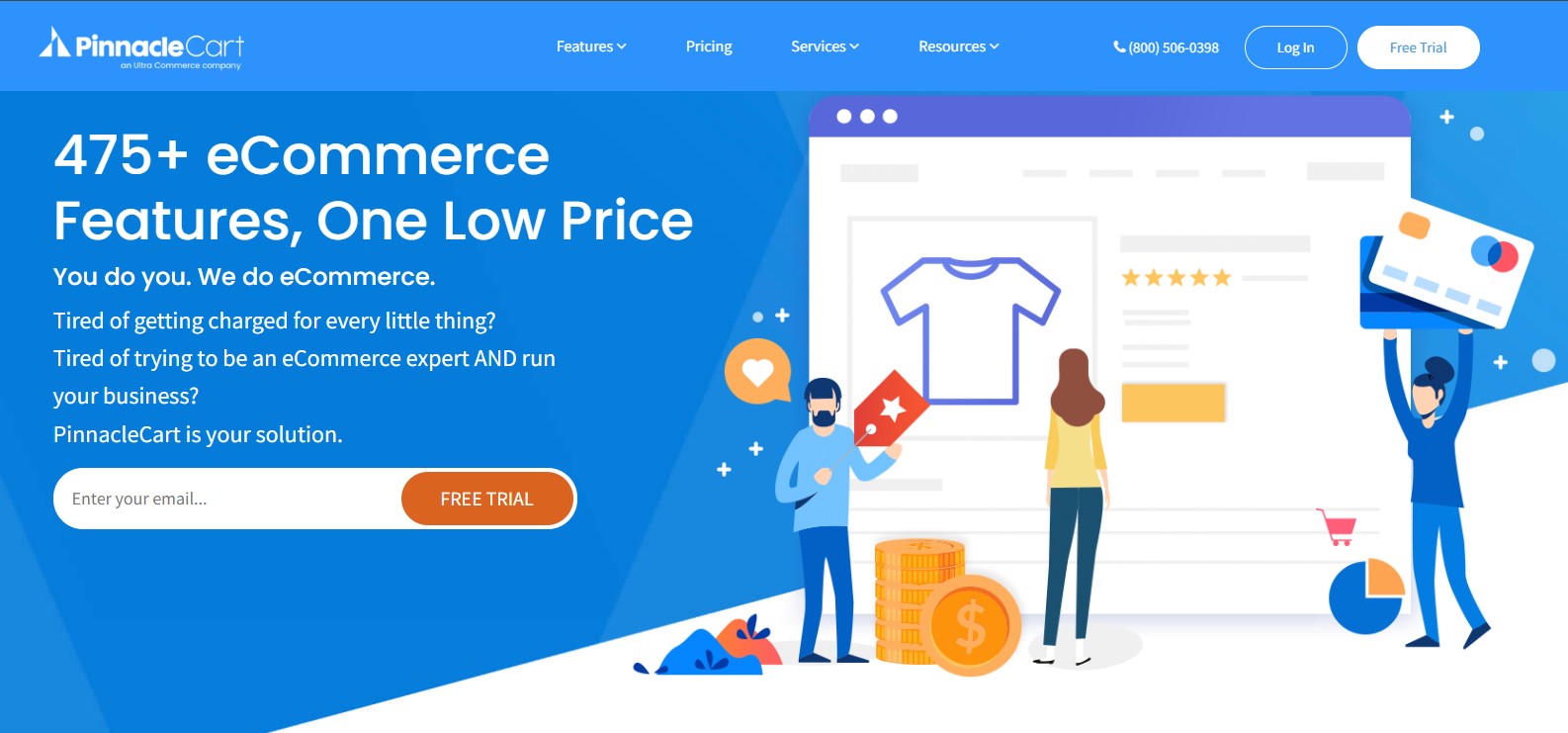
Cost Structure
PinnacleCart’s pricing model differs from Shopify’s fixed plans, offering tiered options to suit different business sizes:
- Standard plan: $79.95 per month for up to 5 admin accounts
- Advanced plan: $199.95 per month for businesses experiencing growth
- Enterprise plan: Custom pricing for larger operations
The platform charges no transaction fees and offers a 14-day free trial with access to all features
Built-in Marketing Tools
PinnacleCart includes several marketing features that eliminate the need for third-party apps. These tools help businesses enhance their online presence and engage customers effectively:
- Advanced SEO capabilities with keyword research tools
- A built-in email marketing system
- QR code generation for promotions
- Drift marketing for abandoned cart recovery
- Integrated sales widgets and live chat functionality
This combination of tools allows you to manage SEO campaigns, run email marketing initiatives, and recover abandoned carts, all from one integrated platform.
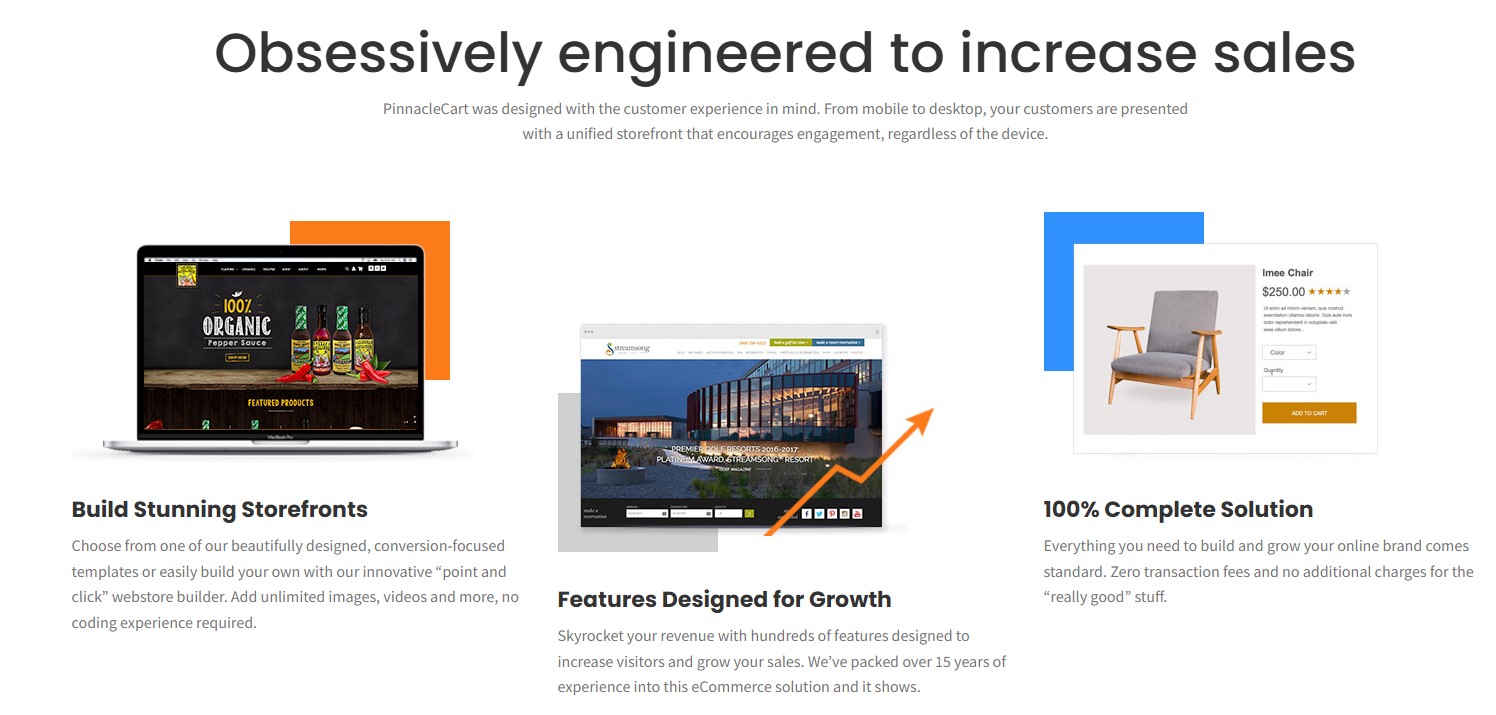
Store Management
Managing a store with PinnacleCart is straightforward, with features tailored for efficient operations.
The platform supports both digital and physical products and offers customization options to meet varied needs:
- Sample product functionality for testing setups
- Bulk product uploads to save time
- Support for custom product variations
Additionally, it allows multiple admin accounts for collaborative management and provides a detailed analytics dashboard to track store performance effectively.
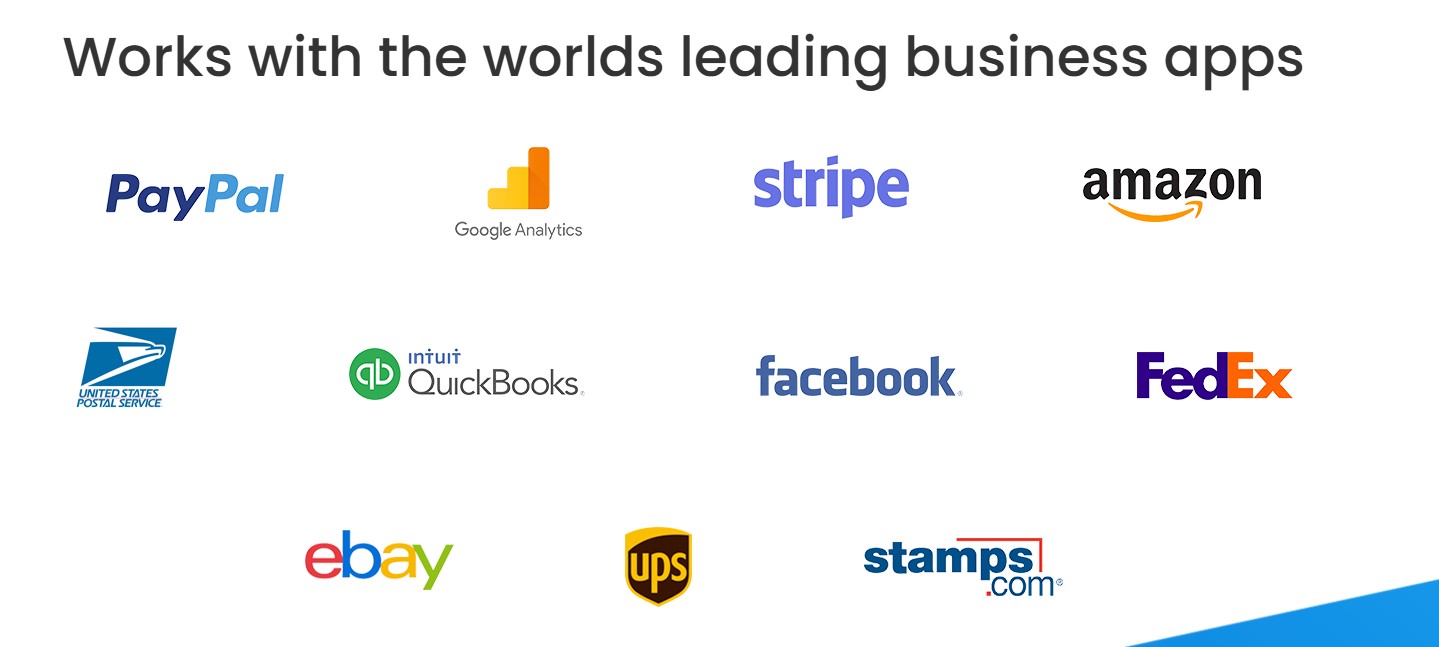
Where PinnacleCart Falls Short
The platform comes with several drawbacks compared to Shopify. The monthly cost runs higher than similar platforms, making it expensive for small businesses.
It offers fewer themes than Shopify, limiting design options.
The platform lacks a built-in point-of-sale system, requiring third-party integration for in-person sales.
Support hours are limited to 6 AM to 5 PM with no weekend coverage.
Bottom Line
Choose PinnacleCart if you want strong built-in marketing tools and don’t mind paying more for them. It works well for medium-sized businesses needing multiple admin accounts and advanced SEO features.
However, if you want lower starting costs or need a point-of-sale system, Shopify might be a better choice.
Big Cartel as a Shopify Alternative
Big Cartel is specifically designed for artists and small creative businesses, offering an affordable and straightforward platform for managing a small-scale online store.
This focus makes it an excellent option for those with a limited product range.
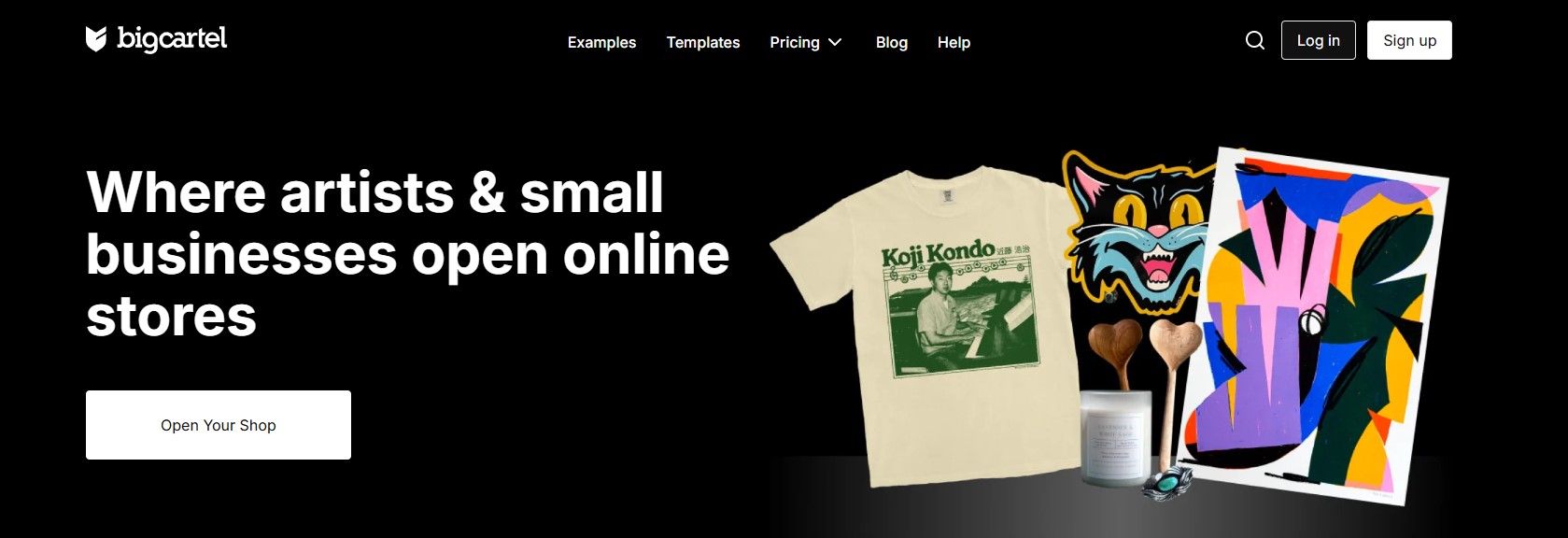
Cost Structure
Big Cartel’s pricing stands out from Shopify with a simpler model:
- Free plan for up to 5 products
- $15 per month for up to 50 products
- $30 per month for up to 500 products

There are no transaction fees beyond standard payment processor charges, but the platform only supports PayPal and Stripe as payment gateways.
Design Features
The platform offers basic design tools that prioritize simplicity and ease of use. These include:
- 18 mobile-optimized themes available at no cost
- Clean and minimal storefront layouts
Sellers can make simple adjustments, such as logo placement and homepage layout edits, using the Store Designer tool.
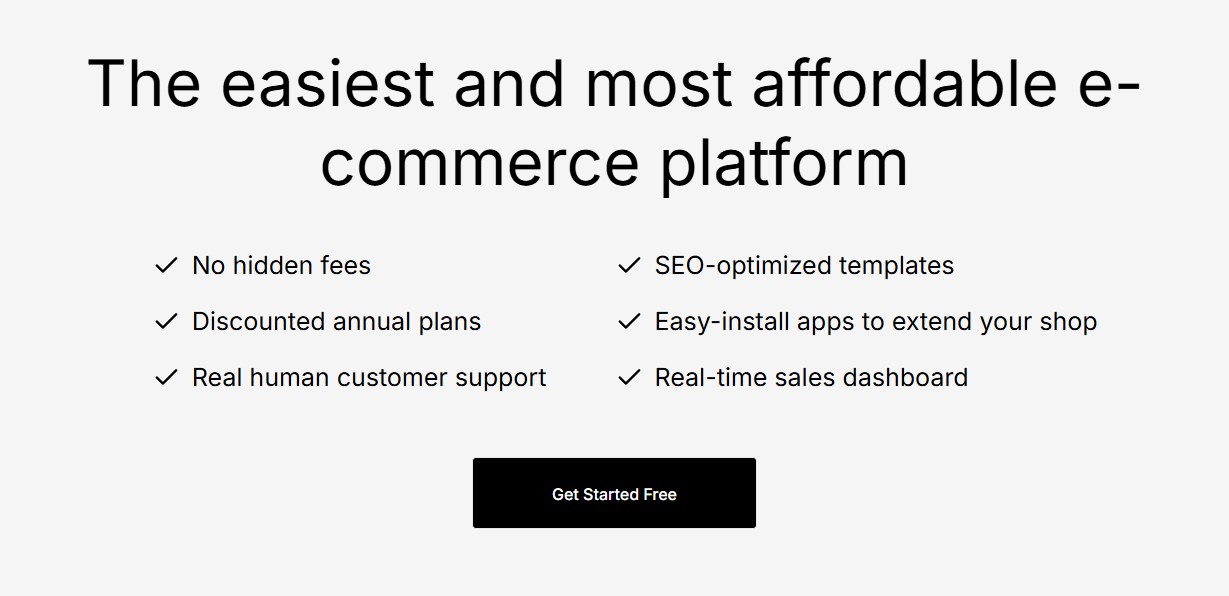
Core Features
Big Cartel includes essential tools to help manage small shops efficiently. These features are tailored to meet the needs of creative sellers:
- Bulk product editing
- Inventory tracking
- Discount code creation
- Google Analytics integration
The platform also supports basic SEO tools and gift card functionality, making it suitable for small-scale operations.
Where Big Cartel Falls Short
Big Cartel shows its limitations in daily use. The platform lacks basic features like product image zoom and customer login options. Support is only available Monday through Friday during business hours.
The product limit of 500 items prevents growth beyond a certain point, and the platform offers fewer payment options than most alternatives.
Adding custom images requires coding knowledge, making simple customization harder than necessary.
Bottom Line
Choose Big Cartel if you’re an artist or maker selling a small number of products and want a simple, affordable solution. It works particularly well for creative businesses selling unique items.
However, if you plan to grow beyond 500 products or need more advanced features, Shopify’s expanded capabilities might be a better fit.
Ecwid as a Shopify Alternative
Launched in 2009 by Ruslan Fazlyev, Ecwid specializes in enabling businesses to integrate e-commerce capabilities into existing websites.
Unlike Shopify, which focuses on standalone e-commerce sites, Ecwid is designed to seamlessly add a store to any platform.

Cost Structure
Ecwid offers a tiered pricing system, starting with a free plan that supports up to 5 products. Paid plans provide additional features and product allowances:
- Venture plan: $25 monthly
- Business plan: $45 monthly
- Unlimited plan: $105 monthly
Built-in Features
Ecwid provides essential tools for small and medium-sized businesses without requiring additional purchases.
The platform supports digital product sales with file sizes of up to 25GB and automatic language detection for global selling.
Paid plans also allow for unlimited product options.
- No transaction fees with any payment gateway
- Instant site creation tools for quick setup
- Integrated product review system

Integration Tools
Ecwid’s integration-first approach simplifies selling across platforms. Code-based installation makes it easy to add a store to any website, while unified inventory management keeps data consistent across all channels.
- Real-time synchronization of product data
- Automatic mobile-responsive design for all devices
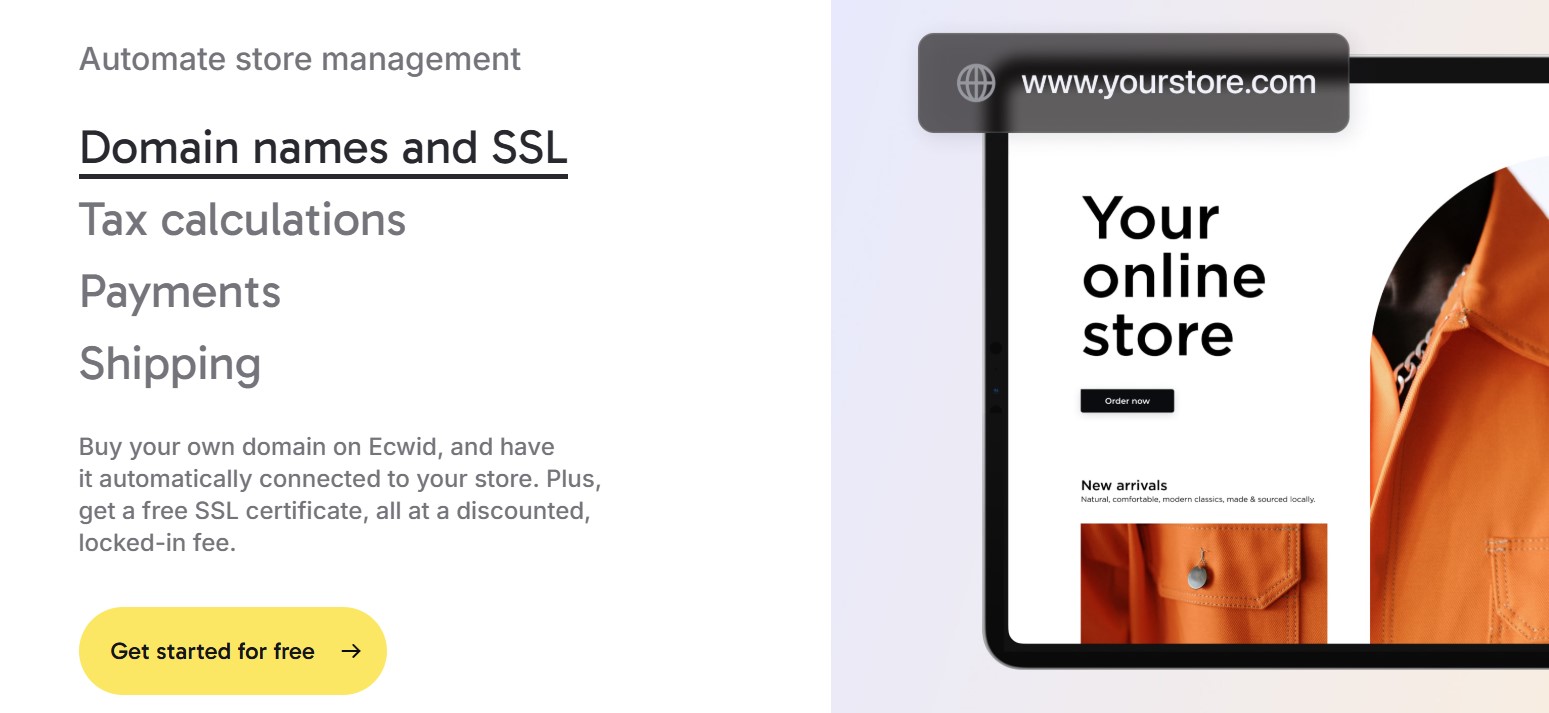
Where Ecwid Falls Short
The integration focus creates several limitations for merchants needing more control. Design options remain restricted compared to Shopify, while the app marketplace offers just 300 integrations.
SEO capabilities provide only basic functionality, and multi-currency features require additional apps to match Shopify’s capabilities.
Bottom Line
Choose Ecwid if you want to add selling capabilities to an existing website or need a simple solution with no transaction fees.
However, if you need extensive customization options or plan to build a dedicated ecommerce site, consider Shopify by considering its stronger standalone features.
Why Consider Shopify Alternatives While Shopify Leads the Market?
While Shopify powers over 4.6 million online stores and handles an impressive $69.7 billion in quarterly sales volume, it’s not necessarily the perfect fit for every business. Each alternative platform offers unique advantages that might better suit specific business needs.
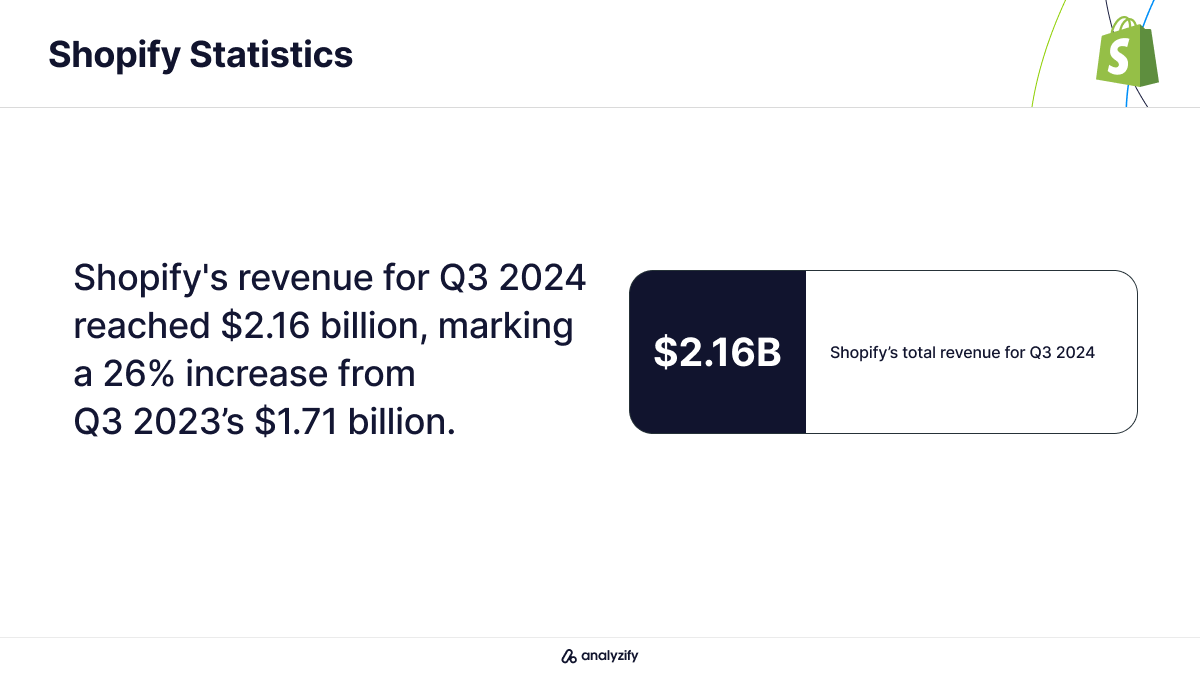
Here’s why you might consider alternatives despite Shopify’s market leadership:
- Specific Business Requirements: While Shopify serves 2 million+ active merchants, platforms like BigCommerce offer stronger B2B features out of the box
- Technical Control: Some businesses need complete code access and customization options that open-source alternatives provide
- Cost Structure: Alternatives often offer different pricing models - from WooCommerce’s free core to Big Cartel’s artist-friendly pricing
- Built-in Features: Many alternatives include features that would require additional apps in Shopify (where 85% of merchants use paid apps)
However, Shopify’s impressive performance during peak seasons (processing $9.3 billion during Black Friday-Cyber Monday) and extensive app marketplace (10,000+ apps) demonstrate why it remains the go-to choice for many businesses.
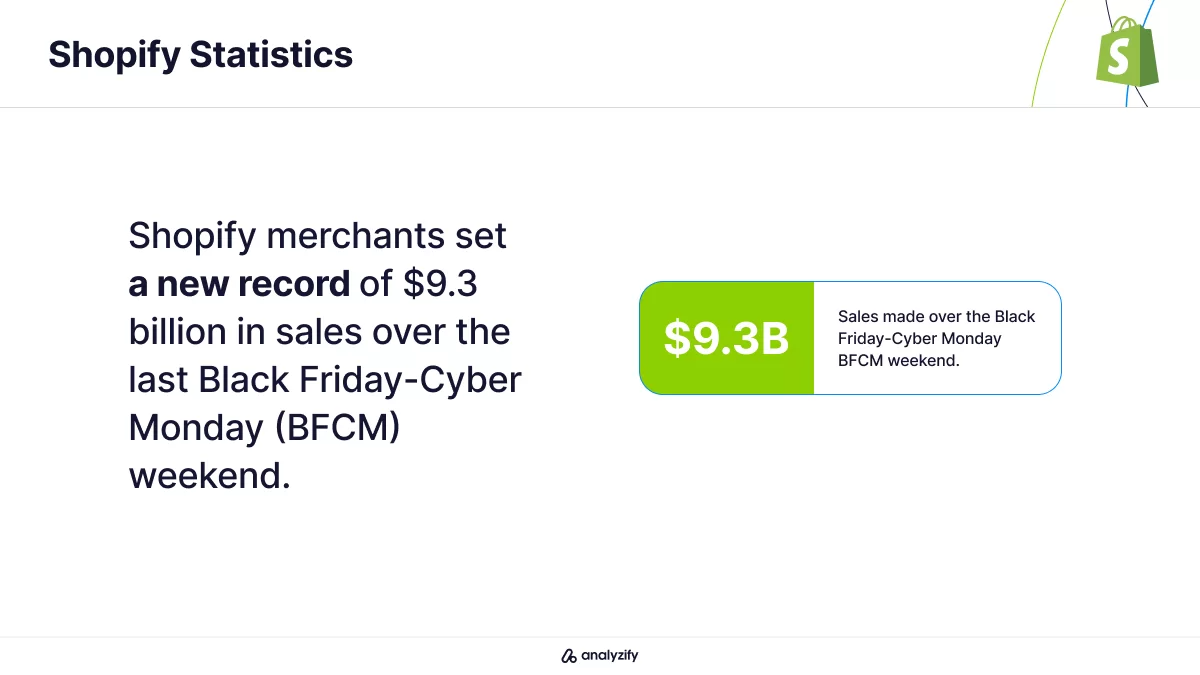
For those focusing on growth and scalability, Shopify’s ecosystem and continuous innovation in areas like AI tools make it a compelling choice.
The key is to recognize that choosing an e-commerce platform isn’t about finding the “best” option, but rather finding the best fit for your specific business model, technical requirements, and growth plans.
Bonus: Explore Shopify Plus Features in 2025!
FAQ: Shopify Alternatives
Here are the frequently asked questions about Shopify Alternatives:
Which Shopify alternative is best for small businesses with limited budgets?
For small businesses watching their budget, WooCommerce and Big Cartel stand out.
WooCommerce offers a free platform with just hosting costs ($3-5/month), while Big Cartel provides a free plan for up to 5 products and paid plans starting at just $9.99/month.
Both platforms offer essential features without requiring significant upfront investment.
Can I switch from Shopify to another platform without losing my data?
Yes, most major alternatives like BigCommerce and WooCommerce offer migration tools and services to transfer your products, customer data, and order history.
However, you’ll need to plan for potential theme and app replacements since these are platform-specific.
It’s recommended to back up all data before migration and possibly work with a developer for a smooth transition.
How do Shopify alternatives compare in terms of technical support?
Support levels vary significantly among platforms. Hosted solutions like BigCommerce and Squarespace offer dedicated customer support similar to Shopify.
Open-source platforms like WooCommerce and PrestaShop rely more on community support and documentation.
Adobe Commerce provides enterprise-level support but at a higher cost. Consider your technical expertise when choosing, as some alternatives require more self-management than Shopify.
Do Shopify alternatives offer similar app marketplaces and integrations?
While no alternative matches Shopify’s 10,000+ apps, each platform has its own ecosystem.
BigCommerce and WooCommerce offer substantial marketplaces, while platforms like Squarespace and
Wix includes more built-in features, reducing the need for additional apps. Consider whether your essential business tools are available on your chosen platform before switching.
Are Shopify alternatives as secure and reliable for processing payments?
Yes, most major alternatives offer secure payment processing.
BigCommerce and Wix integrate with major payment gateways without charging extra transaction fees (unlike Shopify’s fees for external gateways).
WooCommerce and OpenCart give you freedom to choose any payment processor. All reputable platforms maintain PCI compliance and security standards for safe transactions.

































